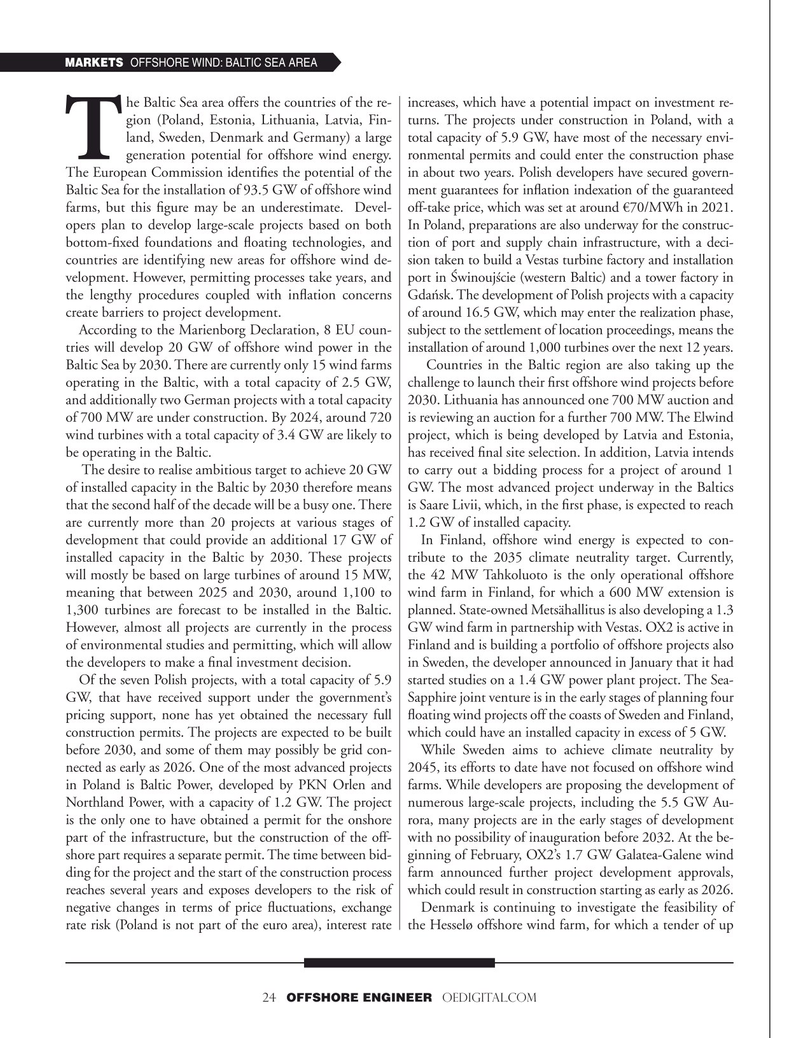
Page 24: of Offshore Engineer Magazine (Jan/Feb 2023)
Read this page in Pdf, Flash or Html5 edition of Jan/Feb 2023 Offshore Engineer Magazine
MARKETS OFFSHORE WIND: BALTIC SEA AREA he Baltic Sea area offers the countries of the re- increases, which have a potential impact on investment re- gion (Poland, Estonia, Lithuania, Latvia, Fin- turns. The projects under construction in Poland, with a land, Sweden, Denmark and Germany) a large total capacity of 5.9 GW, have most of the necessary envi-
T generation potential for offshore wind energy. ronmental permits and could enter the construction phase
The European Commission identi?es the potential of the in about two years. Polish developers have secured govern-
Baltic Sea for the installation of 93.5 GW of offshore wind ment guarantees for in?ation indexation of the guaranteed farms, but this ?gure may be an underestimate. Devel- off-take price, which was set at around €70/MWh in 2021. opers plan to develop large-scale projects based on both In Poland, preparations are also underway for the construc- bottom-?xed foundations and ?oating technologies, and tion of port and supply chain infrastructure, with a deci- countries are identifying new areas for offshore wind de- sion taken to build a Vestas turbine factory and installation velopment. However, permitting processes take years, and port in Swinoujscie (western Baltic) and a tower factory in the lengthy procedures coupled with in?ation concerns Gdansk. The development of Polish projects with a capacity create barriers to project development. of around 16.5 GW, which may enter the realization phase,
According to the Marienborg Declaration, 8 EU coun- subject to the settlement of location proceedings, means the tries will develop 20 GW of offshore wind power in the installation of around 1,000 turbines over the next 12 years.
Baltic Sea by 2030. There are currently only 15 wind farms Countries in the Baltic region are also taking up the operating in the Baltic, with a total capacity of 2.5 GW, challenge to launch their ?rst offshore wind projects before and additionally two German projects with a total capacity 2030. Lithuania has announced one 700 MW auction and of 700 MW are under construction. By 2024, around 720 is reviewing an auction for a further 700 MW. The Elwind wind turbines with a total capacity of 3.4 GW are likely to project, which is being developed by Latvia and Estonia, be operating in the Baltic. has received ?nal site selection. In addition, Latvia intends The desire to realise ambitious target to achieve 20 GW to carry out a bidding process for a project of around 1 of installed capacity in the Baltic by 2030 therefore means GW. The most advanced project underway in the Baltics that the second half of the decade will be a busy one. There is Saare Livii, which, in the ?rst phase, is expected to reach are currently more than 20 projects at various stages of 1.2 GW of installed capacity. development that could provide an additional 17 GW of In Finland, offshore wind energy is expected to con- installed capacity in the Baltic by 2030. These projects tribute to the 2035 climate neutrality target. Currently, will mostly be based on large turbines of around 15 MW, the 42 MW Tahkoluoto is the only operational offshore meaning that between 2025 and 2030, around 1,100 to wind farm in Finland, for which a 600 MW extension is 1,300 turbines are forecast to be installed in the Baltic. planned. State-owned Metsähallitus is also developing a 1.3
However, almost all projects are currently in the process GW wind farm in partnership with Vestas. OX2 is active in of environmental studies and permitting, which will allow Finland and is building a portfolio of offshore projects also the developers to make a ?nal investment decision. in Sweden, the developer announced in January that it had
Of the seven Polish projects, with a total capacity of 5.9 started studies on a 1.4 GW power plant project. The Sea-
GW, that have received support under the government’s Sapphire joint venture is in the early stages of planning four pricing support, none has yet obtained the necessary full ?oating wind projects off the coasts of Sweden and Finland, construction permits. The projects are expected to be built which could have an installed capacity in excess of 5 GW.
before 2030, and some of them may possibly be grid con- While Sweden aims to achieve climate neutrality by nected as early as 2026. One of the most advanced projects 2045, its efforts to date have not focused on offshore wind in Poland is Baltic Power, developed by PKN Orlen and farms. While developers are proposing the development of
Northland Power, with a capacity of 1.2 GW. The project numerous large-scale projects, including the 5.5 GW Au- is the only one to have obtained a permit for the onshore rora, many projects are in the early stages of development part of the infrastructure, but the construction of the off- with no possibility of inauguration before 2032. At the be- shore part requires a separate permit. The time between bid- ginning of February, OX2’s 1.7 GW Galatea-Galene wind ding for the project and the start of the construction process farm announced further project development approvals, reaches several years and exposes developers to the risk of which could result in construction starting as early as 2026. negative changes in terms of price ?uctuations, exchange Denmark is continuing to investigate the feasibility of rate risk (Poland is not part of the euro area), interest rate the Hesselø offshore wind farm, for which a tender of up 24 OFFSHORE ENGINEER OEDIGITAL.COM

 23
23

 25
25